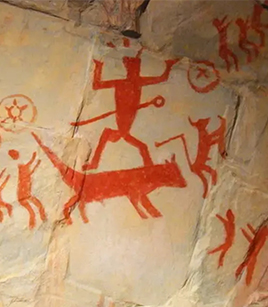Huashan rock art

A photo showing details of the Huashan rock paintings Photo: Courtesy of Shi Lanying & Tang Huisheng
Located on the steep cliffs in the Zuo River basin in the Guangxi Zhuang Autonomous Region, southwest China, the Zuojiang Huashan Rock Art Cultural Landscape is an extensive assembly of historical rock art that contains over 5,000 discrete countable images arranged in about 300 groups. 38 of the rock art sites, which were listed as the UNESCO World Heritage Site in 2016, start from the upper reaches of the Ming River [a tributary of the Zuo River], extend along the Ming River to the middle and lower reaches of the Zuo River, with the overall geographical distribution around 105 kilometers.
The Huashan rock paintings depict human and animal figures as well as bronze drums, knives, swords, bells, and ships. Many of the paintings are thought to “illustrate the life and rituals” of the ancient Luo Yue people, who inhabited the valley of Zuo River in ancient times. These people are believed to be ancestors of the Zhuang people, a Tai-speaking ethnic group who mostly live in modern-day Guangxi.
The age of those paintings is still in dispute, and archaeologists haven’t reached consensus on the studies of these paintings. Some believe that the majority of the rock paintings date from the Spring and Autumn Period (770–476 BCE) to the Western Han Dynasty (202 BCE–8 CE).
At more than 2,000 years old, the rock paintings appear almost as bright as new, without obvious fading. Experts explain that the paintings used a mixture of red ochre (hematite), and animal-and-plant-based glue, giving them excellent corrosion resistance.
How did people draw on the cliff faces over 2,000 years ago? Experts speculate that there are four possible ways. The first way is by climbing up from the ground and painting. The second is by standing on scaffold-like structures. The third possibility is that painters painted while suspended from above with rattan stems. The last method is that painters stood in boats and painted on the cliffs when water levels were sufficiently high. However, these speculations all have major flaws, and cannot satisfactorily explain how those paintings were created.
Edited by REN GUANHONG
